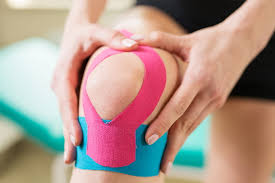Knee pain can be frustrating and limit your daily activities, whether caused by injury, arthritis, or overuse. Taping your knee is an effective way to provide support, reduce pain, and improve mobility.
This guide will walk you through the best taping methods, materials needed, and expert tips to ensure maximum relief and stability.
Why Tape Your Knee?

Taping the knee helps by:
- Providing extra support to muscles and ligaments
- Reducing strain on the knee joint
- Improving stability and alignment
- Enhancing circulation and reducing swelling
- Relieving pain from conditions like runner’s knee, patellar tendonitis, and arthritis
Types of Knee Taping Methods
Depending on your knee condition, you can choose from different taping techniques:
1. Kinesiology Taping (KT Tape)
- Best for: Mild to moderate knee pain, runner’s knee, and patellar tracking issues
- Benefits: Provides flexible support without restricting movement
2. McConnell Taping
- Best for: Patellar instability and chronic knee pain
- Benefits: Offers firm support and helps realign the kneecap
3. Athletic Taping
- Best for: Sports injuries and ligament support
- Benefits: Restricts movement to prevent further damage
How to Tape Your Knee – Step-by-Step Guide
Materials You Need:
- Kinesiology tape (KT tape) or athletic tape
- Scissors
- Skin-prep spray (optional for better adhesion)
Step 1: Prepare the Skin
- Clean and dry the skin to remove oils and sweat.
- Shave the area if necessary to improve tape adhesion.
- Apply a skin-prep spray for extra grip (optional).
Step 2: Apply Kinesiology Tape for General Knee Pain
- Anchor the Tape – Cut a strip of KT tape about 8–10 inches long and place it below your kneecap.
- Guide the Tape Around the Knee – Stretch the tape slightly as you wrap it along the outer knee, following the natural curve.
- Secure the Tape – Apply another strip of tape along the inner knee for added support.
- Rub the Tape – Gently rub the tape to activate the adhesive and ensure it sticks properly.
Step 3: Athletic Taping for Extra Support
- Wrap an Anchor Strip – Apply a strip of athletic tape around the lower thigh, just above the knee.
- Create a Support X – Cross two strips over the front of the knee to form an X shape, adding stability.
- Finish with a Locking Strip – Place a final strip over the top to secure the tape.
Additional Tips for Effective Knee Taping
- Avoid stretching the tape too much, as it can cause skin irritation.
- Do not wrap the tape too tight, which may restrict circulation.
- If you experience increased pain or irritation, remove the tape immediately.
- Kinesiology tape can stay on for up to 3–5 days, while athletic tape should be removed after activity.
Also Read: Spiritual Meaning Of Pain In Left Knee – What Does It Symbolize?
When to See a Doctor
If your knee pain is severe, persistent, or accompanied by swelling, redness, or instability, consult a doctor for further evaluation. Taping is a temporary solution and should be combined with physical therapy and strengthening exercises for long-term relief.
FAQ’s
1. Why should I tape my knee?
Taping helps provide support, reduce pain, improve stability, and enhance circulation, especially for injuries and conditions like runner’s knee or arthritis.
2. What type of tape should I use for knee pain?
Kinesiology tape (KT tape) is best for flexibility and mild pain, while athletic tape provides firm support for injuries and instability.
3. How long can I keep the tape on my knee?
Kinesiology tape can last 3–5 days, while athletic tape should be removed after physical activity.
4. Can taping help with arthritis-related knee pain?
Yes, taping can relieve arthritis pain by reducing strain on the knee joint and improving alignment.
5. Is knee taping safe for everyone?
Yes, but avoid it if you have skin sensitivities, circulation issues, or open wounds. If pain worsens, consult a doctor.
6. How tight should the tape be?
The tape should be snug but not too tight to avoid restricting blood circulation or causing discomfort.
7. Can I exercise with my knee taped?
Yes, taping supports movement and reduces strain, making it helpful for workouts, running, and sports activities.
8. When should I see a doctor instead of taping?
If knee pain is severe, persistent, or accompanied by swelling, redness, or instability, seek medical evaluation.
Final Thoughts
Taping your knee is a simple yet effective way to relieve pain, improve stability, and support movement. Whether you choose kinesiology tape for flexibility or athletic tape for firm support, following the correct technique can make a significant difference. If knee pain persists, seek professional guidance to address the underlying cause and prevent further injury. By using the right taping method and taking preventive measures, you can keep your knees pain-free and stay active longer!
Related Post
- Zimatejigemo – Unlocking the Fusion of Creativity, Identity, and Innovation!
- Tinaypimatelate – The Revolutionary Concept Shaping the Future of Innovation!
- Limhuloxidpov – A Complete Guide to Understanding This Unique Concept!
- Zaxtexporoz – Exploring the Emerging Concept of Innovation and Digital Transformation!
- Lekulent – The Breakthrough Wellness Solution Taking the Health World by Storm!






